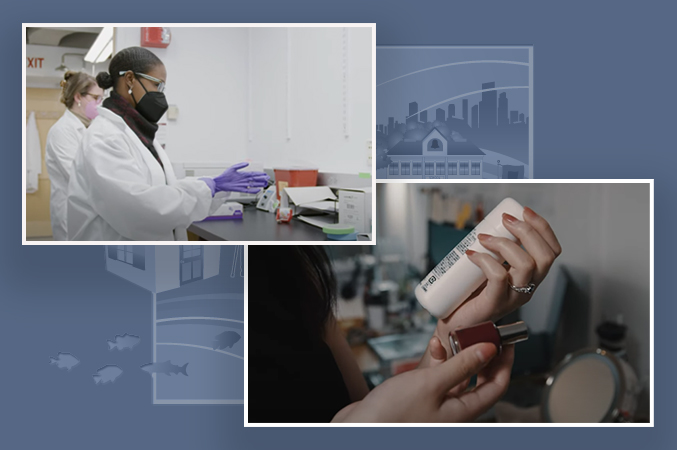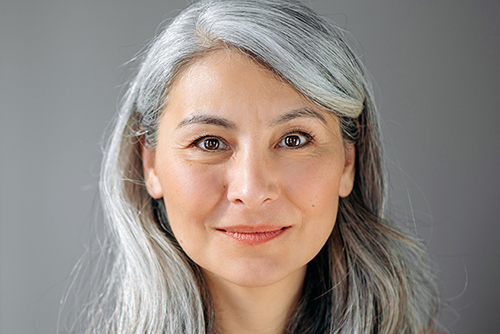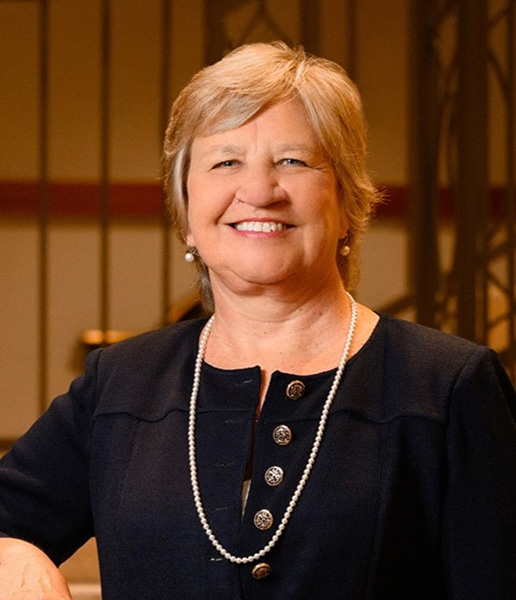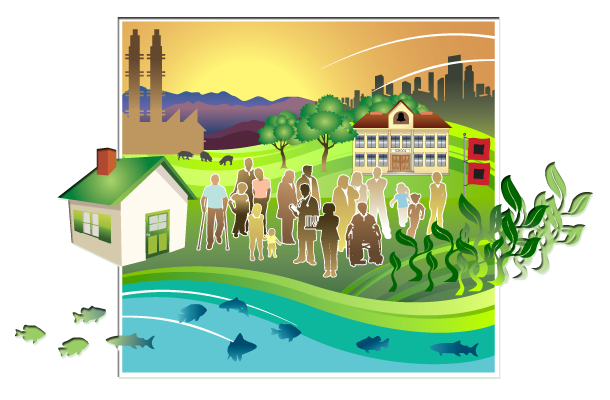Environmental Exposure Training for Health Care Providers Encourages Discussions With Patients

Kathryn Tomsho, Ph.D., principal investigator of the study. (Photo courtesy of Kathryn Tomsho)
NIH-supported researchers developed virtual training for obstetricians and gynecologists (OB/GYNs) about the health risks of phthalate exposure during pregnancy. The training increased the number of OB/GYNs who discussed phthalate risk with their patients.
The researchers based their intervention on the premise that increasing physicians’ understanding of phthalates would encourage them to share that knowledge with their patients. The training focuses on understanding environmental health topics, such as risks of harmful exposures, and acting on that knowledge, such as avoiding or reducing the use of potentially harmful products. A November 2024 paper describes the training and a survey-based evaluation its effectiveness with OB/GYNs.
“Health care providers can play an important role in sharing environmental health information with their patients,” stated Kathryn Tomsho, Ph.D., M.P.H., of the Department of Environmental Health at the Harvard University T.H. Chan School of Public Health, and principal investigator of the project. “They are a trusted source of information for patients, so by educating health care providers, we can get information in the hands of patients.”
Designing a Training Course for Health Care Providers
Phthalates are endocrine disrupting chemicals found in everyday personal care products such as lotion, hair care products, perfumes, and deodorants. Exposure has been linked to issues with pregnancy, including preterm birth, high blood pressure, and low birthweight.
OB/GYNs are, therefore, positioned to influence health-related choices of their patients. In fact, the American College of Obstetricians and Gynecologists (ACOG) released guidance recommending that reproductive health professionals discuss environmental exposures with their patients.
“In environmental health, we know phthalate exposure is an important topic in the reproductive health space,” added Tomsho. “It was great to see ACOG release their guidelines in 2021, but environmental exposures are often not included in medical training. That’s a gap we’re trying to address.”
The research team developed the training in partnership with OB/GYNs in the Region 1 Pediatric Environmental Specialty Unit. Training videos share the perspectives of patients, a scientist, and health care providers on the importance of understanding environmental chemical exposures. Another component of the training describes phthalate-containing products and the health risks associated with them, while the training’s interactive section asks participants about phthalates and health outcomes.
In one patient perspective video, a mother of a school-aged child describes learning about environmental chemical exposures during her pregnancy and how discussing this information with health care providers would have been helpful. In another patient video, a woman considering becoming pregnant discusses knowing of phthalates in personal care products and her hope that health care providers share information on safer product options with their patients. The scientist in the video provides information on where phthalates are found, while the health care providers describe ACOG’s guidance, how they discuss the guidance with their patients, and why it is important to provide this information to patients.

Video stills from a training videos. (Photos courtesy of Kathryn Tomsho)
Determining Effectiveness of the Training Course
The research team wanted to find out whether the training successfully increased health care providers’ knowledge of phthalates and encouraged them to discuss phthalates with their patients. They recruited 203 providers who were actively seeing patients to take the training and complete surveys before and after completing the course.
Surveys assessed providers’ knowledge of phthalates, level of confidence in discussing phthalates, and how often they discussed phthalates with patients. There was a modest increase in scores from 22.3 to 24, with a maximum score of 30. Larger gains were seen in other outcomes. For example, none of the OB/GYNs reported discussing phthalates with patients before the course, but after the course, 86% reported doing so. Similarly, only 1% of providers were confident discussing phthalates with patients before the course, while 86% were confident afterwards.
“The survey results showed us that many of these providers were actively using the information from the training in their practices, and doing so with confidence,” reflected Tomsho. “This is an encouraging sign that the training is an effective way to encourage environmental health discussions between OB/GYNs and patients.”
The researchers plan to explore the possibility of making the virtual training available to more reproductive health professionals. They would also like to assess whether it can be used effectively in other formats, such formal continuing education programs.
NIEHS-Funded Researchers Study How to Effectively Communicate Wildfire Smoke Risk
Although children are at heightened risk for the health effects of wildfire smoke exposure, even at moderate levels of exposure, it is unknown how parents use information from air quality indices to protect their children’s health. A group of NIEHS-funded researchers studied parents’ response to different forms of air quality infographics to learn how to effectively communicate this risk. They found that some air quality index formats, such as the air quality health index, a scale that ranges from 0 to greater than 10, may help parents understand the health risks to children better than the air quality index, which ranges from 0 to 500+. In the study, parents who were given the infographics based on the smaller scale were more likely to say they would take risk-mitigating actions, such as using an air purifier.
NIEHS-Funded Researchers Study Link Between Wildfire Smoke Exposure and Emergency Room Visits
A group of researchers, including NIEHS-funded scientists, studied the causes of more than 90,000 emergency room visits associated with wildfire smoke exposure by performing statistical analyses on health care claims in California from 2012 to 2019. The group found that exposure was associated with more visits to the emergency room for all causes, non-accidental causes, and respiratory reasons, but not cardiovascular reasons. They also found that there was higher risk for health-related issues for certain age groups (children up to 4 years old and adults over 20 years old) and people without air conditioning.
NIEHS-Funded Researchers Find Association Between Health Outcomes and Long-Term Exposure to Wildland Smoke
NIEHS-funded researchers studied the health risks of long-term exposure to wildland fire smoke, complementing numerous studies on the health effects of short-term exposure. Long-term was defined as a 12-month period. The researchers studied exposure to ambient fine particles (PM2.5). Looking at nonaccidental mortality rates from 2007 to 2020 in more than 3,000 counties in the U.S., they found an association between long-term exposure to PM2.5 from smoke and nonaccidental deaths. They also found associations between exposure and deaths due to specific health conditions, such as cardiovascular disease, diabetes, mental health conditions, and chronic kidney disease. These associations were stronger for people aged 65 and above. The team estimates that smoke exposure contributes to about 11,500 nonaccidental deaths per year.

PEPH Environmental Health Chat Podcast Series
Menopause and the Environment
PEPH Environmental Health Chat Podcast Series
Menopause and the Environment
There are gaps in understanding how menopause affects women’s health, particularly how environmental exposures may affect menopause and the transition to menopause. In the August 2024 PEPH podcast, Jodi Flaws, Ph.D., discusses her NIEHS-funded research examining how exposure to chemicals called phthalates may affect women’s reproductive aging. She also discusses gaps in what we know about menopause, and how research can inform clinical care to help women manage and treat their symptoms during the transition to menopause.

PEPH Grantee Highlight
Linda McCauley, Ph.D.
As dean of the Nell Hodgson Woodruff School of Nursing at Emory University in Atlanta, Linda McCauley, Ph.D., R.N., works at the intersection of nursing, children’s health, and environmental and occupational health sciences. She also leads Emory’s efforts to foster partnerships between researchers and communities to decrease environmental exposures and translate scientific findings into action.
Funding Opportunities
There are no funding announcements at this time.








